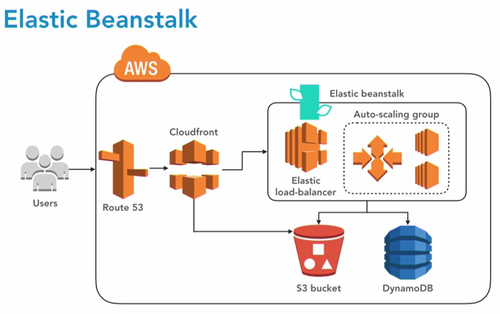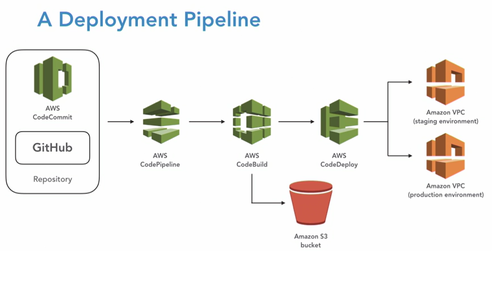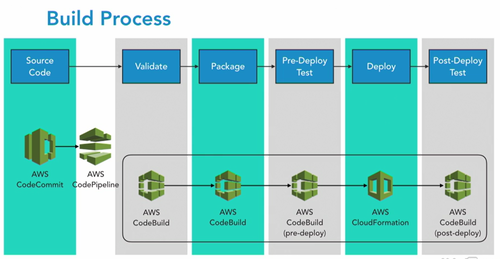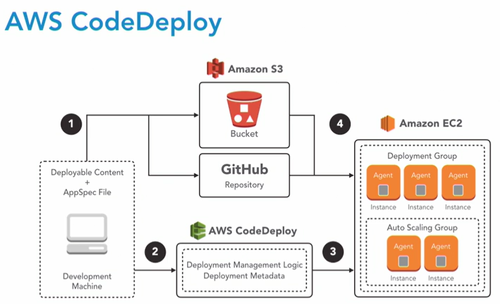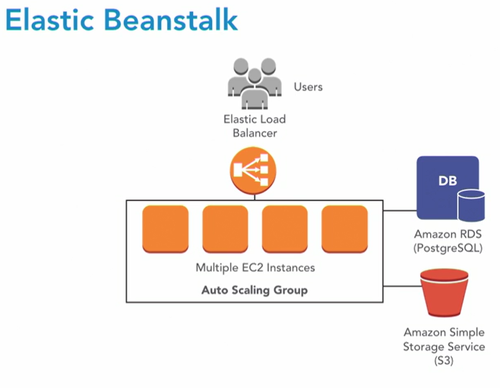AWS Certified Developer Associate
Anazon Web Services
IAM
- Policies specify specific permissions
- Roles are a collection of policies that services are assigned in
- To groups can be assigned policies as well
Security
User pools
Directories that provide signup and sign-in options for you app users.
Anonymous Access
Anonymous Access creates Identity pools for you.
Identity Pools with Cognito
Identity pools provide AWS credentials to grant your users access to other AWS services.
Roles
Roles are collections of policies to which services are assigned.
IAM
In IAM, which areas need to be considered with restrictions and access? Computing, Storage, Database, and App services
Development
DynamoDb
Schema-Less database that only requires a table name and primary key
Lambda
AWS Lambda is a computing service that lets you run code without provisioning or managing servers.
DynamoDB
Can you use Oracle RDBMS with DynamoDB? No; DynamoDB is for non-relational databases, and Oracle is a relational database.
Messaging and Event Driven
Message => step functions => event/lambda => SNS => SQS => Lambda
States Machines
State machines are made up of states, their relationships, and the input and output defined by the Amazon States Language.
SNS
SNS pushes its messages out to its subscribers.
SQS
SQS stores the messages until someone reads them and processes them off the queue. SQS is useful for sending and receiving messages between apps.
Deployment, Scalability and Monitoring
Elastic Bean Stalk
Deploy and scale web apps and services
CloudFormation Stacks
Configure and Maintain system
CloudFormation
Provisions and management stacks of aws resources based on the template you created to model your infrastructure
Elasticache
Service to launch and scale and manage a distributed in memory cache Caching is great to performance and efficiency
Cluster
- Redis
- Memcache
CloudFront
Global Content Delivery Network CloudFront is secure and quickly delivers data, video, applications, and APIs. This means it has shorter distances to deliver and higher performance.
Cloud Watch
You can create high-resolution alarms and automated actions. These alarms can monitor costs for your budget, metrics, events, and logs. CloudWatch alarms are part of Elastic Beanstalk, and there are two of them. What are the two alarms? CloudWatch has two alarms to monitor loads, and they trigger when the alarms are too high or too low for the auto scaling group.
AWS: Deploying Your Application to the cloud
Code Commit
Git compatible, secure and scalable source control. Can be trigger by AWS Tools It is recommanded to use IAM user. IAM has a specific section for CodeCommit credentials. Recommanded: Use MasterBranch as a trigger for deployments
- Access: CodeCommitFullAccess
How can you move files from one source control management tool to CodeCommit ? Create an empty repo. Clone your empty codecommit repo. Manually copy and commit the files into it. Then push them to the repo.
Commands
- > aws Configure
- > git --version
- > git config --global username
Code Build
buildspec.yml
- phases : install : commands
- phases : install : finally
Have to install Java sdk & maven We can have more than one BuildSpec file
- How can you pass values to control my codebuild scripts? Use Environment Variables.
- Where can you find your build logs?
- CloudWatch logs
- CodeBuild console
Create Build Project
- Choose manage image
- We are allow to create a role
- Timeout is very important
- Specify a VPC if we need to access to other servers or services during buiild, but it isn't very common
- Choose s3 and a bucket to store the artifacts
- Standard format is zip
Code Deploy
- appspec.yml : tells codedeploy what to do with our generated binaries and any additional files we may need
- Genrally: takes the web archive and copy it to the webapps folder of a tomcat web server where it will be deployed automatically by apache tomcat
- Files: source / destination
Deployment
Deployement groups
a way to identify the servers we are deploying to
- Name
- Role of EC2 to code deploy
- Choose to uncheck the Load Balencer
- triggers, alarms, rollbacks
Create deploymenet
Now we have an Application and a Deployment group we can create a deployment
- Wich files to deploy
- where to deploy them
s3 URL
s3://bucketname/file
- Ruby is required by our code deployment agent
- Download an install file:
- > wget https://aws-codedeploy-us-west-1.s3.amazonaws.com/latest/install
- > chmod +x ./install
- > sudo .install auto
- > sudo service codedeploy-agent status
Important to check: EC2 Console > right clic server > settins > IAM Role > S3Admin
- Code deploy through the code-agent will reach out to s3 to our bucket with the deployment binary
KeyPoints
What's needed to create a revision .ZIP file? An AppSpec and the code binaries
Code Pipeline
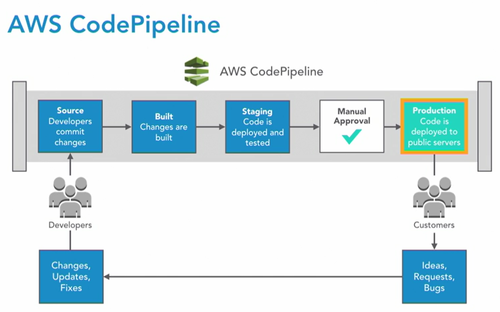 Source > Build binary > Test > Production
Source > Build binary > Test > Production
Create a pipeline
- Create a role: this role will allow code pipeline to access this particular pipeline wich will be created in our pipeline
- even AWS itself not have access to resources within our account unless we provide privileges
- Specify a branch
- CHoose detection option : code pipeline vs cloud watch
Configure the build stage
- Choose a build provider: codeBuild
- Configure: Operating system, runtime, runtime version = can be upgraded in buildspec. yml file
Deploy Stage
- Select Application and Deployment group\
Go
As soon as the pipeline is created, it is running so make sure it is what you want
Key Points
- Continuous integration and deployment pipeline
- various tools
- Passe the output to the next stage
- Jenkins like: difference it is a service
- simple to complex workflows
- Support approvals
When is it a good practice to add a CodePipeline approval step? during deployment to servers that are being used regularly Disrupting QA Testers by taking down their server unannounced is a bad practice. You should consider an approval for this, just like production deployment approvals.
- It is possible to generate more than one artifact on one build
Elastic BeanStalk
- HighAvailability
- Backups
- Health Checks
- Alarms
- Track Metrics
- Code deploy agents
- database: constant patching, updates, backups, monitoring
Create
what will we do
- Create a server
- give it a domain name
- install all the required softwares
- handle the deployment
- handle execution
Environment
In beanstalk, an application is a container for environments the environment is the application architecture it is made up of
- application servers
- web servers
- load balencers
- auto scalling group
- database
- ....
By default: Web Base Application the "ugly" domain name can be modified with a C-Name but if we want to change it, the environment has to be deleted.
Finally: It will trigger a cloud formation build
Use it with code pipeline
- send directly the compiles java class to beanstalk
- create a secondary buildspec.yml files that is going to create an artefact
HOW TO : Pipeline > edit > Edit Stage > Add Action > Create Project > Configure > Specify the name of the new buildspec.yml file > Give a name to the multiple Output artefacts
